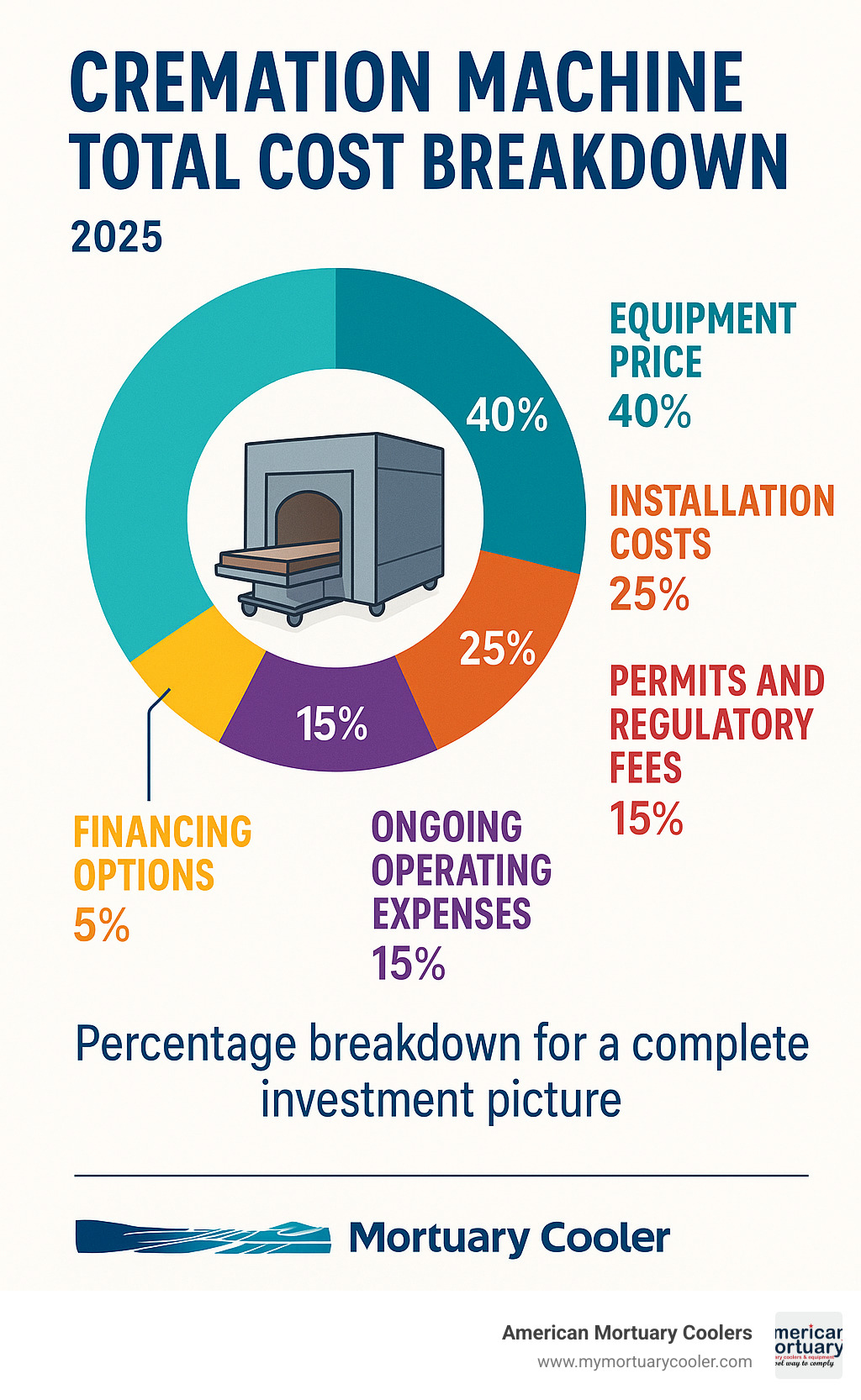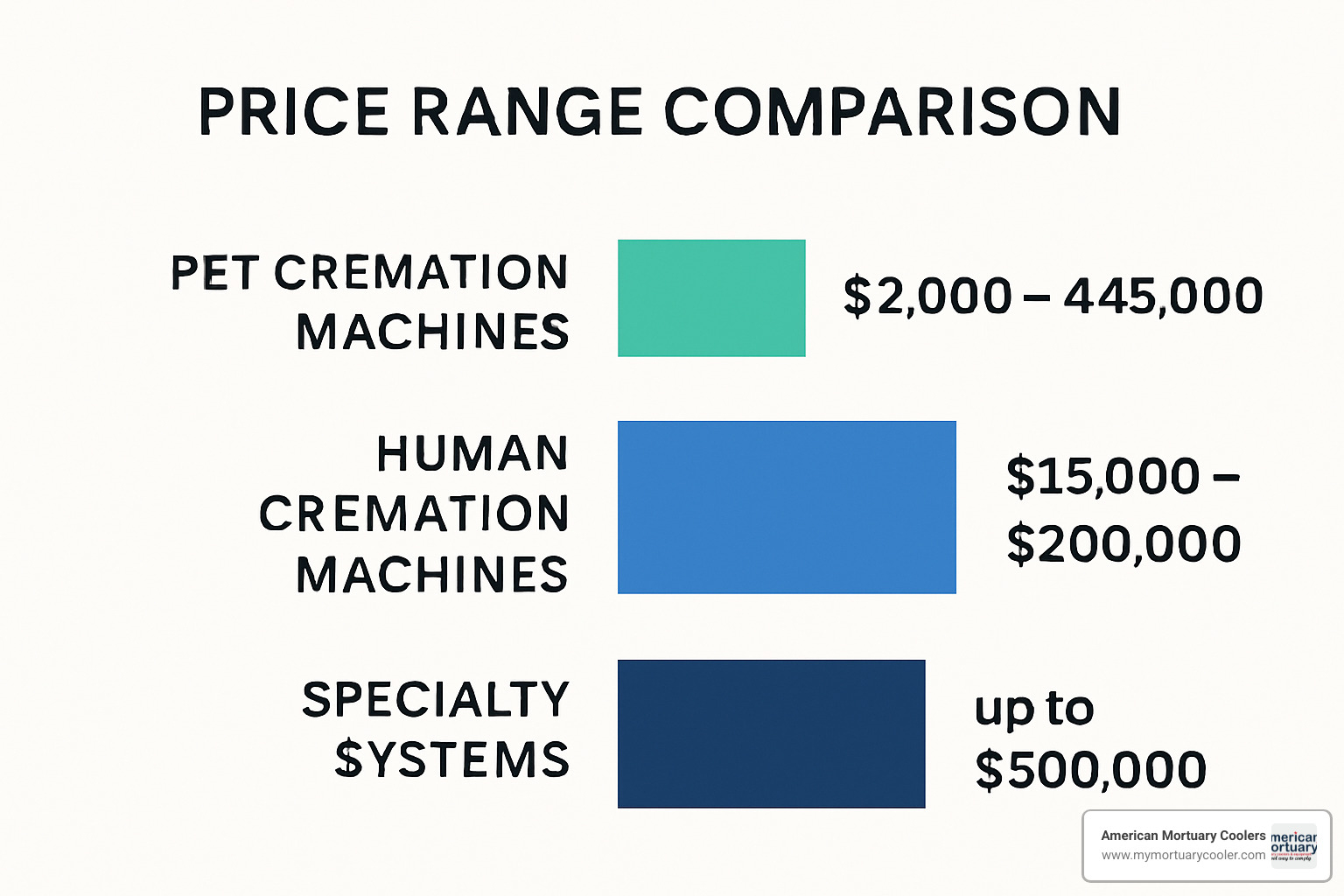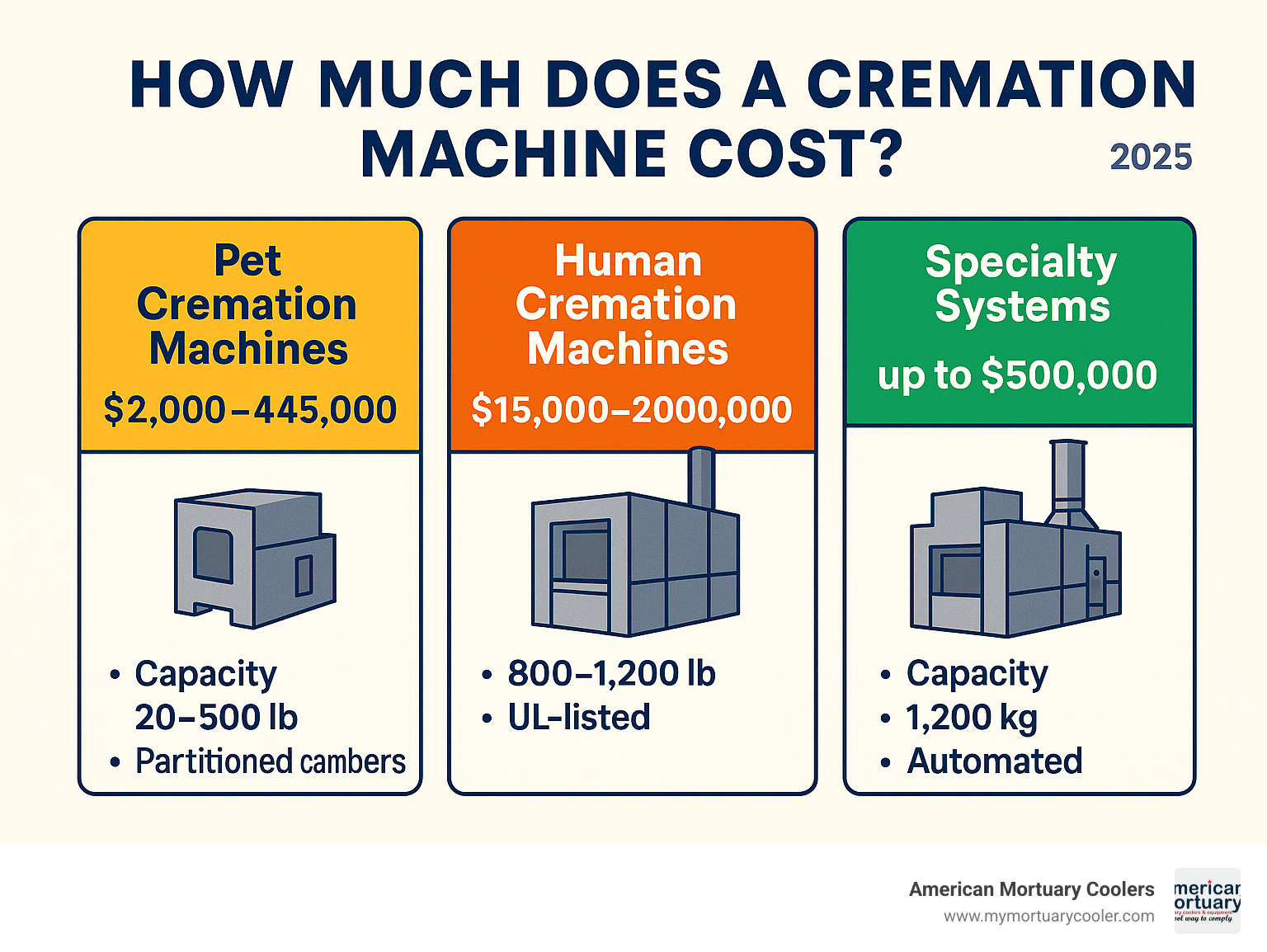Why Understanding Cremation Machine Costs Matters More Than Ever
When funeral home directors ask how much does a cremation machine cost, the answer isn't as simple as a single price tag. With cremation rates climbing past 56% nationally and projected to exceed 75% within 20 years, investing in the right equipment has never been more critical for your bottom line.
Quick Answer: Cremation Machine Cost Ranges
- Pet cremation machines: $2,000 - $45,000
- Human cremation machines: $15,000 - $200,000
- Complete installed systems: $300,000 - $500,000
- Used/refurbished units: 40-60% less than new
But here's what most suppliers won't tell you upfront: the sticker price represents just the starting point of your total investment. Installation costs often match or exceed equipment prices, permits can take months to secure, and ongoing fuel expenses add $20-$40 per cremation.
As one Ohio funeral director finded when researching costs, trying to get transparent pricing felt like "nailing jello to a wall." Hidden fees for shipping, site preparation, and regulatory compliance can easily double your initial budget.
I'm Mortuary Cooler from American Mortuary Coolers, and I've helped funeral directors steer how much does a cremation machine cost for over two decades as a national mortuary equipment supplier. My experience has shown me that smart buying decisions start with understanding the complete cost picture, not just the equipment price.

How much does a cremation machine cost vocab to learn:
- crematorium machine price
- cremation furnace for sale
- how much does it cost to start a cremation business
What Is a Cremation Machine and How Does It Work?
If you've ever wondered what actually happens inside a cremation machine, you're not alone. These precision instruments are a far cry from the crude furnaces people might imagine. The proper term for a human cremation machine is a "retort," though you'll also hear them called cremation furnaces or incinerators depending on what they're designed to handle.
Think of a modern cremation machine as a highly controlled oven that operates at extreme temperatures—typically between 1,400°F and 1,800°F. That's hot enough to reduce organic matter to bone fragments and ash through a carefully managed process that takes about 60-90 minutes for human remains.
The engineering behind these machines is actually quite sophisticated. Most modern units feature a dual-chamber design where the primary chamber holds the remains while the secondary chamber burns off gases and smoke to meet strict emissions standards. This two-stage process is what keeps crematoriums compliant with environmental regulations.
Here's something that surprises many funeral directors when they first learn how much does a cremation machine cost: the refractory lining represents one of the biggest ongoing expenses. These specialized fire-resistant materials form the heart of any cremation machine, withstanding those extreme temperatures day after day. But they don't last forever—expect to replace refractory every 3-7 years at a cost of $30,000-$50,000.
Modern systems also include automated controls with digital PLC (Programmable Logic Controller) panels. These computerized systems monitor temperatures, air supply, and timing cycles, advancing each process stage automatically. A typical cycle includes a 45-second purge, preheat phase, cremation period, and cool-down—all managed without constant human oversight.
Main Uses Across Industries
Cremation machines serve a much broader market than just traditional funeral homes. Understanding these different applications can help you choose the right equipment for your specific needs.
Human funeral services represent the largest market segment, requiring UL-listed equipment that meets strict safety standards. These units typically handle 800-1,200 pound capacity with those 60-90 minute cycle times we mentioned.
Pet cremation services have become a rapidly growing segment with very different requirements. Pet units handle smaller capacities (20-500 pounds) but often feature partitioned chambers that allow multiple small animals to be cremated simultaneously while keeping remains completely separate.
Medical waste processing represents another specialized application. Hospitals and veterinary clinics use these incinerators for pathological waste, with strict temperature and retention time requirements.
Agricultural applications focus on livestock carcass disposal, particularly during disease outbreaks. These heavy-duty units can process up to 1,200 kg per cycle and are built for continuous operation.
Key Components You'll See on Spec Sheets
When you start shopping for cremation equipment, spec sheets can feel overwhelming. Here are the critical components that actually matter for your operation and budget.
The primary chamber is your main cremation area, sized by weight capacity. Look for units with quick-change modular hearth tiles—they minimize downtime during maintenance and can save you thousands in service calls over the equipment's lifetime.
The secondary burner creates that high-temperature afterburn zone that reduces emissions. This feature can add $10,000-$20,000 to your equipment cost, but it may be required by local regulations.
Loading systems come in manual and automated versions. Manual loading works fine for smaller operations, but hydraulic auto-loaders ($15,000-$35,000) reduce staff strain and improve safety in high-volume facilities.
Digital controls with modern PLC systems and color touch screens are pretty much standard now. Just avoid overly complex systems with hidden programming modules—they increase service costs and create headaches when something goes wrong.
Finally, refractory quality can make or break your long-term maintenance budget. Premium refractory costs more upfront but lasts longer between those expensive rebuilds. It's one area where spending more initially often saves money over time.
How Much Does a Cremation Machine Cost? (Sticker Price Only)

When funeral directors first ask how much does a cremation machine cost, they're usually looking for that bottom-line equipment price. I get it—you need to know if this investment even makes sense before diving into all the extras.
The truth is, cremation machine prices span a massive range. You could start with a basic pet unit for around $2,000, or invest in a fully automated human cremation system that tops $200,000. That's quite a spread, and it all comes down to what you're planning to cremate and how much volume you expect.

Here's something important to remember: these are equipment-only prices. The actual cost to get a cremation machine up and running is typically much higher once you factor in installation, permits, and site preparation. But let's start with the basics.
Pet Cremation Machines — how much does a cremation machine cost for animals?
Pet cremation offers the most affordable entry point into the cremation business. When clients ask how much does a cremation machine cost for animal services, I usually tell them to think in three price tiers.
Entry-level pet units run $2,000 to $5,000 and handle about 20 to 50 kg loads. These basic machines work well for small veterinary clinics that only need occasional cremation services. They're simple, manual units without fancy controls, but they get the job done.
Mid-range pet systems cost $5,000 to $25,000 and can handle larger animals up to 300 pounds. These units often include digital temperature controls and partitioned cremation capability, which is huge for business flexibility. You can cremate multiple small pets at once while keeping their remains completely separate.
High-end pet cremation machines range from $25,000 to $45,000 and can process animals up to 500 pounds. These premium units feature full automation, multiple partition options, and smokeless operation that keeps neighbors happy.
Pet cremation machines offer faster ROI because you can run communal cremations for cost-conscious pet owners while charging premium prices for private services. Many operators tell me they paid off their pet units within the first year.
Human Cremation Machines — how much does a cremation machine cost for funerals?
Human cremation equipment represents a much bigger investment due to size requirements and strict safety regulations. When funeral directors ask how much does a cremation machine cost for human services, I break it down into three categories.
Basic human retorts start around $15,000 to $50,000 for imported units. These machines handle the standard 800 to 1,000 pound capacity with manual loading and basic refractory lining. While the upfront cost seems reasonable, many operators find these units require more maintenance and have shorter lifespans.
Mid-range systems cost $50,000 to $100,000 and offer better value for most funeral homes. These units typically feature 1,000 to 1,200 pound capacity, semi-automatic controls, and UL listing for the US market. The improved emissions control helps with permit approval, which can save you headaches down the road.
Premium automated systems range from $100,000 to $200,000 but include features that busy funeral homes love. Full automation with auto-loaders reduces staff strain, while advanced digital controls with touch screens make operation simpler. These units also include premium refractory materials that last longer between expensive rebuilds.
Most human cremation cycles take 60 to 90 minutes, and the machines are typically gas-fired for consistent temperature control. US-manufactured units cost more but come with better warranties and local service support.
Aquamation & Alternative Systems
Water cremation, also called alkaline hydrolysis, represents the newest technology in body disposition. When people ask how much does a cremation machine cost for aquamation, the answer is significantly higher than traditional flame cremation.
Basic aquamation units start around $210,000 for the equipment alone. These systems use heated water and alkali to break down remains, producing only bone fragments and a sterile liquid. The process takes longer than flame cremation—typically 3 to 6 hours—but uses much less energy overall.
Premium aquamation systems can reach $329,900 and include advanced automation and larger capacity. The eco-benefits appeal to environmentally conscious families, and many states are updating regulations to allow this method.
Installation costs for aquamation add another $50,000 to $100,000 due to specialized plumbing requirements and water treatment systems. However, operating costs tend to be lower over time since there's no fuel consumption and minimal emissions.
For detailed pricing information on aquamation systems, check out our complete guide to alkaline hydrolysis costs. The technology is still evolving, but early adopters report strong customer interest in this gentler alternative.
Beyond the Sticker: Factors That Drive Total Project Cost

The equipment quote you receive is only the first line of the bill. In most projects installation and compliance double the out-of-box price.
Key cost drivers
- Fuel type – Natural gas is cheapest to run; propane or diesel add 20-40 % to annual fuel spend. Bringing a new gas line can add $15,000 before you perform a single cremation.
- Capacity choices – A 1,200-lb retort costs roughly 20 % more than an 800-lb model but delivers 50 % more throughput, often making the bigger unit the better long-term value.
- Automation level – Manual loading saves $15k-$35k upfront; auto-loaders pay for themselves in busy facilities through faster cycles and fewer staff injuries.
- Manufacturer location – U.S.-built machines run 30-50 % higher than imports, yet arrive UL-listed and have domestic parts/service.
Installation, Shipping & Site Prep
Large retorts require cranes, reinforced flooring, and professional rigging. Budget guidelines:
- Freight & crane set: $12,000-$18,000 (more for overseas freight)
- Utility connections: $15,000-$30,000 for gas, 480 V 3-phase electric, and ventilation
- Stack & monitoring equipment: $10,000-$25,000
- Building modifications: varies, but $30,000-$80,000 is common
Suppliers usually include a three-day install and staff training, yet the prep work around it can stretch several weeks.
Regulatory & Environmental Compliance Costs
- Zoning & public hearings: $2,000-$5,000 for legal/consulting help
- Air-quality permits: $1,000-$10,000, plus 4-16 weeks of waiting
- Annual stack testing: $3,000-$8,000 every year
- Building permits: $1,000-$5,000
For current emission limits, the Cremation Association of North America tracks evolving state rules.
Operating & Maintenance Expenses (per year)
- Fuel: $20-$40 per cremation (roughly $10k-$20k at 500 cases)
- Maintenance contracts: $2,500-$7,500
- Refractory relines: $30k-$50k every 3-7 years
- Consumables & electricity: $3,000-$8,000
When you evaluate offers, look at total cost of ownership, not just the first invoice.
Smart Buying: Supplier Comparison, Financing & Warranties
Choosing a supplier purely on list price can turn an exciting growth plan into a maintenance nightmare. Vet each company for credibility, service coverage, and lead time before signing.
U.S. Manufacturers vs. International Suppliers
- U.S.-built: 30-50 % higher price, but UL-listed, 8-12 week delivery, and local technicians.
- Imports: Attractive base prices ($43,500-$58,000 FOB) yet freight, duty, and code updates often erase much of the savings. Parts and service delays are the biggest hidden cost.
A Chicago director who chose an import saved $15k upfront but spent nearly that much retro-fitting for U.S. electrical codes and overnight-shipping parts.
New vs. Used & Refurbished
Used units can run 40-60 % cheaper than new, but always pay for an independent inspection. If refractory is due for a $40k reline, the “deal” disappears. Limited 30-90-day warranties also make financing tougher.
More tips here: Burn Less Cash: Quality Used Cremation Equipment for Sale.
Financing, Leasing & Payment Plans
- Bank loans: 10-20 % down, 5-7-year terms
- Equipment leases: lower monthly outlay; operating leases run 2-8 % of equipment value per month
- Manufacturer programs: often flexible and industry-specific
Don’t forget tax breaks—Section 179 and bonus depreciation can offset a large chunk of first-year cost. Get pre-qualified with our lending partner’s quick form: Financial Corp Leasing.
In short, balance sticker price with reliability, service, and financing that aligns with your cash flow.
Frequently Asked Questions About Cremation Machine Pricing
When funeral directors start researching how much does a cremation machine cost, they often have similar questions about timelines, permits, and warranties. Here are the most common concerns we hear from our customers.
How long from order to first cremation?
The journey from placing your order to performing your first cremation isn't quick—plan for 3-6 months minimum for the complete process. This timeline surprises many first-time buyers who expect faster turnaround.
Manufacturing time varies significantly by supplier. US-built units typically require 8-12 weeks from order to completion, while international suppliers often need 12-24 weeks before your equipment even ships. Add another 2-4 weeks for overseas shipping and customs clearance.
Permitting often takes longer than manufacturing. While your equipment is being built, you'll need 4-16 weeks for regulatory approvals depending on your location. Some states move quickly, while others require extensive review processes and public hearings.
Site preparation happens parallel to manufacturing and permitting. Building modifications, utility connections, and stack installation typically require 2-8 weeks depending on complexity. Simple installations in existing facilities move faster than ground-up construction projects.
Installation itself is surprisingly quick—most suppliers complete setup and training in 3-5 days. However, final inspections and regulatory sign-offs can add another 1-3 weeks before you're cleared to operate.
Do pet and human machines need different permits?
The permitting landscape varies dramatically between pet and human cremation, and many buyers underestimate these differences when calculating how much does a cremation machine cost in total.
Pet cremation typically falls under animal control or agricultural regulations in most jurisdictions. These permits are often simpler to obtain and cost less than human cremation permits. Some rural areas treat pet cremation similarly to livestock disposal, with minimal regulatory oversight.
Human cremation requires funeral board licensing and much more stringent environmental permits. You'll need to demonstrate compliance with funeral industry regulations, not just equipment safety standards. This process involves more agencies and typically costs more in fees and legal consultation.
Air quality permits apply to both types of cremation, but emission standards may differ. Human cremation facilities often face stricter requirements for particulate matter and opacity measurements. Pet facilities might have more lenient standards, especially for smaller capacity units.
Zoning requirements frequently distinguish between pet and human facilities. Many communities allow pet cremation in industrial zones where human cremation would be prohibited. Residential proximity restrictions are often more stringent for human cremation facilities.
What warranty length is standard?
Warranty coverage directly impacts your long-term costs, making it a crucial factor when evaluating how much does a cremation machine cost over its lifetime.
Standard equipment warranties typically cover 1-2 years on parts and workmanship. US manufacturers often provide longer coverage than international suppliers, and some premium brands offer extended warranties as a selling point.
Refractory warranties deserve special attention since lining replacement represents your largest maintenance expense. Most suppliers offer 3-5 years prorated coverage on refractory materials. This means if your lining fails after two years on a five-year warranty, you'd pay 60% of replacement cost rather than the full amount.
Extended service plans are available for additional cost and often make financial sense for high-volume operations. These plans typically cover routine maintenance, emergency repairs, and priority service response. Annual service contracts cost $2,500-$7,500 but can prevent costly downtime and extend equipment life.
The key is understanding what's not covered. Most warranties exclude damage from improper operation, inadequate maintenance, or normal wear items like gaskets and filters. Always read the fine print before signing, and factor warranty limitations into your total cost calculations.
Conclusion
Understanding how much does a cremation machine cost requires looking far beyond the equipment sticker price. While pet units start around $2,000 and human systems can exceed $200,000, your total investment including installation, permits, and setup often doubles the equipment cost.
The numbers tell a clear story: that $150,000 retort might seem expensive, but over 10 years of operation, fuel and maintenance costs can exceed the original purchase price. Smart buyers focus on total cost of ownership, factoring in ongoing expenses like the $20-$40 per cremation in fuel costs and those inevitable $30,000-$50,000 refractory rebuilds every few years.
Here's what we've learned after helping funeral directors across all 48 contiguous states steer these decisions: the cheapest option upfront rarely proves most economical long-term. That bargain import unit might save money initially, but when you factor in shipping delays, compliance modifications, and limited service support, the savings often evaporate.
At American Mortuary Coolers, our Tennessee-based team specializes in custom mortuary solutions and can provide turnkey guidance for your cremation equipment investment. We've seen too many directors get burned by focusing solely on sticker price instead of considering the complete picture.
Whether you're considering your first cremation machine or expanding existing services, focus on reputable suppliers, quality equipment, and comprehensive support to ensure your investment serves your community for decades to come. The families you serve deserve reliable service, and your business deserves equipment that won't leave you scrambling for repairs during peak times.
The cremation industry isn't slowing down—with rates climbing past 56% nationally and headed toward 75%—now is the time to make informed equipment decisions. Don't let sticker shock prevent you from exploring your options, but don't let low prices blind you to hidden costs either.
Ready to explore your options? Contact our team for personalized guidance on cremation equipment selection, financing, and installation. We're here to help you make informed decisions that benefit both your business and the families you serve.
For additional insights into cremation equipment costs and market trends, read our comprehensive guide on navigating cremation equipment costs.



















